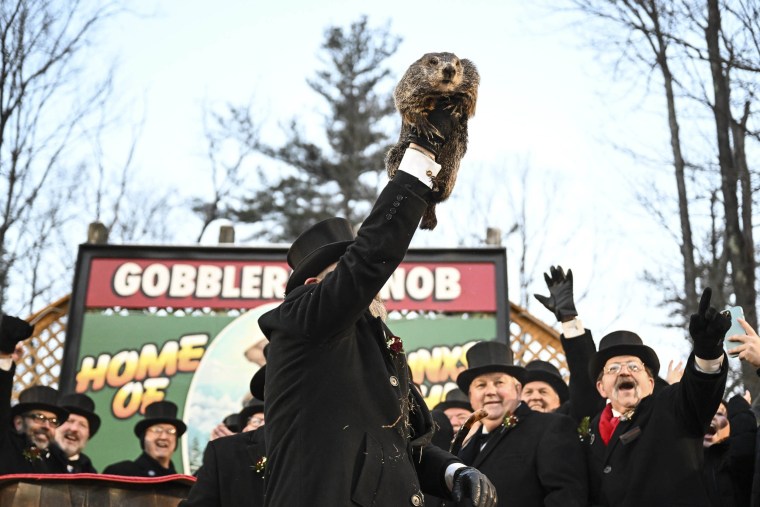UPDATE (Feb. 2, 2024 10:30 a.m. E.T.): Punxsutawney Phil did not see his shadow this morning. Perhaps we will finally see an early spring this year (or perhaps not.)
Much of the U.S. has had a heck of a January. Freezing cold. Pummeling snow and ice. Frozen cars. Horrific world news. Who wouldn’t want a bit of February (and furry) fun?
I’m a biologist who studies marmot behavior, so I may be biased. But my preferred midwinter festival is Groundhog Day. Today is the only holiday I’m aware of that celebrates animal behavior. And I don’t mean the behavior of the Homo sapiens who crowd into Punxsutawney, Pennsylvania, to watch Punxsutawney Phil be pulled from his burrow to prognosticate about the weather by a bunch of cold, overdressed gentlemen. I’m talking about seasonal patterns of behavior, which biologists refer to as phenology.
Today is the only holiday I’m aware of that celebrates animal behavior. And I don’t mean the behavior of the Homo sapiens who crowd into Punxsutawney, Pennsylvania.
These patterns are fascinating for a lot of reasons, but they also can provide insights about the climate and environment relevant to humans. If only most humans listened to these signals as much as groundhogs do.
After 40 years and eight species, I could spend hours (and thousands of words) opining on why this animal deserves our attention — and not just one day out of the year. Groundhogs (also known as woodchucks) are one of the 15 species of cat-sized and charismatic (at least to me!) rodents called marmots. These days I spend much of my time keeping alive the world’s second-longest-running studies of a wild mammal — the 62-plus-year study of yellow-bellied marmots who reside in and around the Rocky Mountain Biological Laboratory near Crested Butte, Colorado. Groundhogs, like all marmots, spend their summers getting fat. Remarkably, studies have shown that they don’t have any physiological consequences of obesity. Marmots then spend their winters avoiding winter by hibernating, an extraordinary adaptation that permits animals to massively slow their metabolism and live off their fat the entire winter. Think about it: Eat all summer, sleep all winter.
But I’ll spare you my extensive catalogue of marmot facts, for now.
On a basic level, Groundhog Day is a holiday about hibernation and phenology. Phenology is the study of the timing of biological seasonal events, and all hibernators have to emerge and make decisions about whether or not it’s time to get back to the business of living.
Our work has shown that marmots are emerging earlier than they did in the past, and we suspect that this reflects changing weather patterns. Like many species, yellow-bellied marmots — the ones I study in Colorado — are astutely attuned to their environment. Their lives literally depend on it. The decision to emerge is also influenced by social factors — for example, male marmots must emerge early. Emerging early through a deep snowpack is risky (predators are around and there’s limited food) but essential if males are to have a chance to reproduce.
Marmots are pretty good at managing the risk of predation by using a variety of senses to detect predators, and they have a number of behavioral responses once they do. They emit alarm calls, run and then hide in the safety of their burrows. None of the species have wordlike communication (a few species, like meerkats and chickens, do), but they communicate risk quite effectively and dynamically with their alarm calls. Some marmots are more reliable callers than others, and individuals pay attention to caller reliability when inferring predation risk after hearing a call. The decisions they make about re-emerging from their burrows are optimized and quite sensitive to the cost-benefit ratio of hiding versus emerging.
The holiday we celebrate now evolved from Pagan and Christian midwinter festivals. In Germany, people looked for the predictive ability of European hedgehogs, cute, softball-sized spiny rodents that also hibernate. Old German lore predicted that when the hedgehog saw its shadow, spring would be delayed, because a sunny midwinter day probably meant that there was a climate-stabilizing high-pressure system around. However, if the hedgehog didn’t see its shadow, spring would come sooner, because the weather was in flux. When the Pennsylvania Dutch were looking to continue this fun tradition, they discovered that groundhogs hibernated, as well. Sadly, the data I’ve seen suggest that using a hibernating fur ball is a flawed way to predict the future. But that doesn’t mean we can’t use the beginning of February to celebrate animal behavior.
Indeed, I never miss the chance to celebrate, whether at home in sunny Los Angeles or teaching my undergraduate field and marine biology course in Moorea, French Polynesia, where February is the rainy season and very hot and humid. There, I regale my students after dinner and on the marine lab’s dock with stories of marmots and groundhogs as we toast the animals and the behavior that make this day possible. And maybe, hopefully, remind ourselves that humanity isn’t quite as exceptional as we’d like to think. We share this planet with incredible creatures, many of whom have a lot to teach us. If we’d like to learn.
